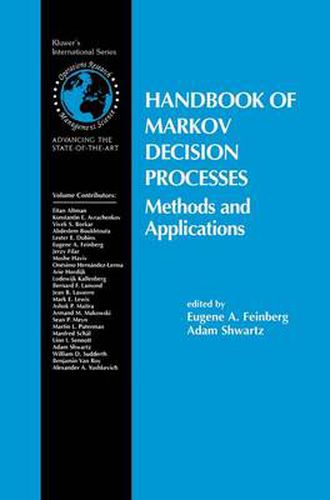Readings Newsletter
Become a Readings Member to make your shopping experience even easier.
Sign in or sign up for free!
You’re not far away from qualifying for FREE standard shipping within Australia
You’ve qualified for FREE standard shipping within Australia
The cart is loading…






This title is printed to order. This book may have been self-published. If so, we cannot guarantee the quality of the content. In the main most books will have gone through the editing process however some may not. We therefore suggest that you be aware of this before ordering this book. If in doubt check either the author or publisher’s details as we are unable to accept any returns unless they are faulty. Please contact us if you have any questions.
Eugene A. Feinberg Adam Shwartz This volume deals with the theory of Markov Decision Processes (MDPs) and their applications. Each chapter was written by a leading expert in the re spective area. The papers cover major research areas and methodologies, and discuss open questions and future research directions. The papers can be read independently, with the basic notation and concepts ofSection 1.2. Most chap ters should be accessible by graduate or advanced undergraduate students in fields of operations research, electrical engineering, and computer science. 1.1 AN OVERVIEW OF MARKOV DECISION PROCESSES The theory of Markov Decision Processes-also known under several other names including sequential stochastic optimization, discrete-time stochastic control, and stochastic dynamic programming-studiessequential optimization ofdiscrete time stochastic systems. The basic object is a discrete-time stochas tic system whose transition mechanism can be controlled over time. Each control policy defines the stochastic process and values of objective functions associated with this process. The goal is to select a good control policy. In real life, decisions that humans and computers make on all levels usually have two types ofimpacts: (i) they cost orsavetime, money, or other resources, or they bring revenues, as well as (ii) they have an impact on the future, by influencing the dynamics. In many situations, decisions with the largest immediate profit may not be good in view offuture events. MDPs model this paradigm and provide results on the structure and existence of good policies and on methods for their calculation.
$9.00 standard shipping within Australia
FREE standard shipping within Australia for orders over $100.00
Express & International shipping calculated at checkout
This title is printed to order. This book may have been self-published. If so, we cannot guarantee the quality of the content. In the main most books will have gone through the editing process however some may not. We therefore suggest that you be aware of this before ordering this book. If in doubt check either the author or publisher’s details as we are unable to accept any returns unless they are faulty. Please contact us if you have any questions.
Eugene A. Feinberg Adam Shwartz This volume deals with the theory of Markov Decision Processes (MDPs) and their applications. Each chapter was written by a leading expert in the re spective area. The papers cover major research areas and methodologies, and discuss open questions and future research directions. The papers can be read independently, with the basic notation and concepts ofSection 1.2. Most chap ters should be accessible by graduate or advanced undergraduate students in fields of operations research, electrical engineering, and computer science. 1.1 AN OVERVIEW OF MARKOV DECISION PROCESSES The theory of Markov Decision Processes-also known under several other names including sequential stochastic optimization, discrete-time stochastic control, and stochastic dynamic programming-studiessequential optimization ofdiscrete time stochastic systems. The basic object is a discrete-time stochas tic system whose transition mechanism can be controlled over time. Each control policy defines the stochastic process and values of objective functions associated with this process. The goal is to select a good control policy. In real life, decisions that humans and computers make on all levels usually have two types ofimpacts: (i) they cost orsavetime, money, or other resources, or they bring revenues, as well as (ii) they have an impact on the future, by influencing the dynamics. In many situations, decisions with the largest immediate profit may not be good in view offuture events. MDPs model this paradigm and provide results on the structure and existence of good policies and on methods for their calculation.